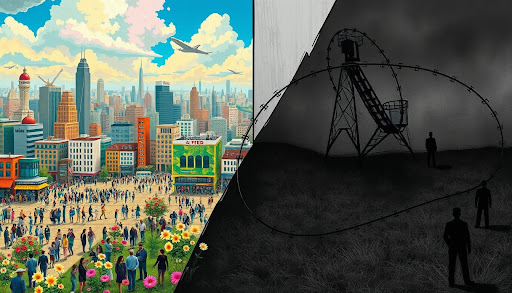Political polarization in America
In the ever-changing world of American politics, a big issue has emerged: political polarization. This guide will dive into what causes this divide, its effects on our country, and how we can work to fix it.
Political polarization means there’s a big gap between different political views. People and groups have very strong and opposite opinions on many topics. This has changed how politics works and has affected our society and culture.
Key Takeaways
- Political polarization in America has become a big problem, with a growing gap between different political views.
- Many things contribute to this, like different beliefs, the influence of media and social media, and the deepening of partisan politics.
- This polarization has serious effects, causing problems in how our government works and creating a bigger divide in our society.
- It’s important to understand the causes and effects of political polarization to find ways to solve it.
- Fixing this issue will take effort from everyone, including politicians, the media, and the public.
What is Political Polarization in America?
Political polarization in the United States means the gap between the Democratic and Republican parties is growing. This gap is not just between the parties but also within them. It affects many areas of American politics.
Defining the Concept
Political polarization is when people’s views and actions on politics start to split. In the US, this is seen in the big differences between the two main parties. People on both sides are less willing to find common ground on important issues.
Historical Context
The divide in US politics started in the mid-20th century. The Democratic and Republican parties began to stand out more on social and economic issues. The civil rights movement, the Vietnam War, and conservative ideas all played a part in this.
As time went on, the partisan divide in US politics got worse. The parties took very different stances on many topics, like healthcare, taxes, and social policies. This history of political polarization in the US has made finding common ground very hard.
| Year | Democratic Party Ideology | Republican Party Ideology |
| 1960 | Center-left | Center-right |
| 2020 | Center-left | Right-wing |
“The rise of political polarization in the United States has been a gradual but steady process, with the parties growing further apart on a wide range of issues.”
Causes of Political Polarization
The political polarization in the United States is complex. It involves ideological differences and the impact of media and social media. Knowing these causes is key to fixing the growing gap in American politics.
Ideological Differences
The main cause of political polarization is the growing ideological divide. Political parties have become more extreme. This makes it hard to find common ground and work together.
Role of Media and Social Media
The media and social media have made political polarization worse. Partisan media and social media create spaces where people only see views that match theirs. This makes their beliefs stronger. Also, it’s easy to spread false information, which makes things worse.
| Factors Contributing to Political Polarization | Impact on American Politics |
| Ideological Differences | Heightened “us versus them” mentality, reduced willingness to compromise |
| Role of Media and Social Media | Creation of echo chambers, amplification of misinformation, and prioritization of engagement over factual accuracy |
It’s important to understand the causes of political polarization in the US. This knowledge helps us find ways to close the ideological divide. It also helps in promoting unity and cooperation in politics.
“The greatest weapon against political polarization is the ability to listen, understand, and empathize with those who hold different views.”
Political Polarization in America
The political divide in the US is growing. The gap between the two major parties is getting wider. Debates on healthcare and immigration show this divide. The legislative process is also getting stuck because of it.
Politics in the US is suffering because of this polarization. Lawmakers often disagree, making it hard to find common ground. This has led to a breakdown in how the country is governed. Each side focuses more on winning than on making good laws.
| Indicator | Democratic Party | Republican Party |
| Ideological Placement (1-100 scale) | 65.2 | 77.7 |
| Percentage who say the other party’s policies are a threat to the nation | 86% | 90% |
| Percentage who say they would be “displeased” if their child married someone from the other party | 45% | 35% |
The data shows a deep divide between the two parties. There’s more distrust and less social connection. This makes it hard to find common ground and compromise.
“Political polarization has become a defining feature of American politics, with the two major parties moving further apart on key issues and the public following suit.”
Fixing this problem will take effort from everyone. We need to find ways to work together again. This is key to keeping the US political system stable and effective.
Impacts of Political Polarization
Political polarization in America has big effects on both government and society. As people become more divided, these effects are seen more clearly.
Gridlock in Governance
One big problem is the gridlock in government. Lawmakers stuck in their views make it hard to find common ground. This makes it tough to pass important laws.
This slowdown hurts the government’s ability to solve big problems. It makes it hard to serve the American people well.
Social and Cultural Divide
Political polarization also widens social and cultural gaps. People tend to stick with their views, making it harder to understand others. This leads to less civil talk and more tension.
The impacts of political polarization go beyond politics. They affect how we govern and live together. Finding ways to bring people together is key for the nation’s future.
| Impact | Description |
| Gridlock in Governance | Difficulty in reaching bipartisan solutions and enacting meaningful legislation, leading to a slowdown in the decision-making process. |
| Social and Cultural Divide | Increased social tensions, reduced civil discourse, and a lack of understanding between individuals with differing viewpoints. |
“The consequences of political polarization are not limited to the political arena; they also reverberate through the fabric of our society, shaping the way we interact with one another and the challenges we face as a nation.”
Conclusion
Political polarization in America is a complex issue. A mix of solutions is needed to tackle it. The divide comes from deep beliefs and changes in media and social talks. But, we can bridge this gap by talking more constructively.
To solve this, we must understand and feel for each other’s views. We should also learn more about civic issues and listen to different opinions. This way, we can move towards a future where we work together, not against each other.
The future of the US depends on how we handle this polarization. We must face this challenge head-on and stick to democracy’s values. By doing so, we aim for a united and prosperous America. A place where everyone can come together and look forward to a better future.
FAQ
What is the definition of political polarization in America?
In America, political polarization means a big gap between the left and right. This gap is in beliefs, values, and policies people want. It shows a growing divide between the two main political parties and their supporters.
What are the historical roots of political polarization in the United States?
The roots of political polarization in the US go back to the beginning. The two-party system, regional and cultural differences, and social and economic issues have all played a part. These factors have made the divide between the left and right grow over time.
What are the primary causes of political polarization in America?
The main reasons for political polarization in the US include big ideological differences. Media and social media also play a big role. Plus, how people sort themselves geographically and the changes in the two-party system have made things worse. These factors have made it hard to find common ground and work together.
How has political polarization affected the current state of American politics?
Political polarization has changed American politics a lot. It has led to more gridlock and less effective policymaking. It has also made it harder to find common ground between the two parties. This has made it tough to work together.
What are the impacts of political polarization on governance and society in the United States?
Political polarization affects both governance and society in the US. It has caused problems in making laws and solving big issues. It has also made it harder for democratic institutions to work well. In society, it has made people more divided, leading to more tension and less common ground.







“After attending a town hall meeting, I witnessed firsthand how political polarization affects constructive discussions and divides communities.”
Comment: “How can individuals bridge the gap and engage in productive dialogue amidst such strong political divides in society?”
Author Reply: “Engaging in active listening, empathy, and understanding different perspectives can help foster productive dialogue and bridge the gap.”
To foster unity, engage in respectful conversations with those who hold differing political views. Embrace empathy and open-mindedness.
Insightful post on political polarization in America. An important analysis shedding light on the divided political landscape. Great read!
This insightful post delves into the complexities of political polarization in America, highlighting its impact and offering solutions.